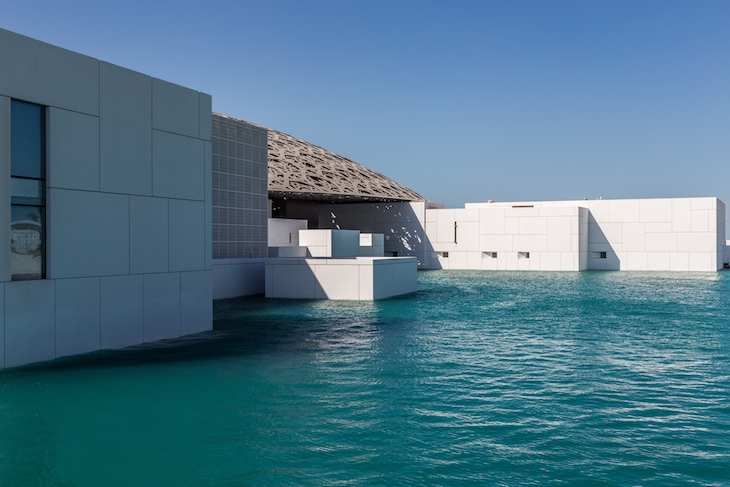On the gently lapping shores of the Persian Gulf, in the steely shadow of the Burj Khalifa, I bump into former chief inspector of schools Sir Michael Wilshaw: I in my dishevelled blue trunks, he in his well-fitted white T-shirt (always strong on uniforms). We are guests of the Varkey Foundation’s global summit on education and skills. Whilst I am there to explain the V&A Museum’s new programme to support design teaching in industrial communities, Sir Michael is still rightly beating the drum for strong leadership and high standards. Aged 72, he remains a model of Carlylian workfulness, mentoring headteachers in Argentina while supporting a multi-academy trust in Derby. We are both full of admiration for the Brent art teacher Andria Zafirakou, winner of the Global Teacher Prize. She tells me it was Picasso’s ‘Weeping Woman’ that first set her on the path to art education.
I take the opportunity of being back in the United Arab Emirates to revisit the Louvre Abu Dhabi. Do believe the hype: it is a spectacular endeavour. The Jean Nouvel architecture provides a mesmerising canopy, under which a dappled sun glints onto generous piazzas and encircling waterways. There are lots of spaces and places to think and ponder, made pleasant by a cooling breeze. No sign yet of da Vinci’s ‘Salvator Mundi’, but the collection is truly stellar. Best of all, the museum has revived the tradition of acquiring period rooms, the high point of which is a 1920s oak-panelled salon taken from Jacques-Emile Ruhlmann’s Paris apartment for Lord Rothermere. ‘Where are the British?’ asks one Emirati arts official, enquiring of our long connections with the Gulf. ‘It is so strange that France is now doing all this and you are not.’
The V&A’s own period room purchase continues to ignite debate. As demolition began at Robin Hood Gardens, a New Brutalist housing estate in Poplar, we salvaged a three-storey section of the façade and original interior fittings. And now some of it is heading to the Venice Biennale for an upcoming V&A exhibition on the future of social housing. Its 1970s architects, Alison and Peter Smithson, imagined that the decline of industry in the East End might usher in a new cultural era. ‘We could have a new Venice in London,’ they wrote. Their Corbusier-inspired estate, with its ‘streets in the sky’, would provide the accompanying council accommodation. However, Robin Hood Gardens fell into disrepair and, despite campaigns by the Twentieth Century Society and some residents, was slated for redevelopment. At the V&A, we have been both praised for preserving part of this important site, and criticised for wasting funds and ‘artwashing’ regeneration. But acquiring for posterity and addressing contemporary design seems exactly what the V&A should be doing.
A more consensual celebration of decorative art is under way in Leeds. The 300th anniversary of Thomas Chippendale’s birth has inspired some wondrous exhibitions of his work at Leeds City Museum, Temple Newsam and, of course, Harewood House — which succinctly brings together the genius of Chippendale’s furniture with Robert Adam’s interiors. What I like about Harewood is that, if you search carefully, you can find the Bafta which the current Earl of Harewood, David Lascelles, was awarded for producing Inspector Morse. The real hope is that this renewed focus on the Shakespeare of English furniture might save his name from being instantly connected to a Las Vegas troupe of beefcake strippers (so named after the faux-Chippendale armchairs in their hotel).
At home in north London (inevitably), I discover that the Stroud Green council ward I live in has the highest proportion of Labour party supporters in the country. Some 6 per cent of adults are members of the party — which is exactly the same per capita ratio as membership of the Chinese Communist Party.
Excitement grows about a new centrist party being formed in the face of frustrations over Brexit and, ahem, other considerations. Prospective leaders of any new faction deny the reports. Such fissures are never easy, as familial and personal ties to party go deep — which makes journalists’ lofty criticism of centrist MPs, of either main party, rather ill-judged. But having left Parliament a year ago, I would say that for all the immediate angst of rupture, the shock is absorbed and (as ever in politics) the water goes over your head. Indeed, you can come out the other side feeling refreshed and energised. Like you’ve had a swim in the Persian Gulf. With or without Sir Michael Wilshaw.






Comments